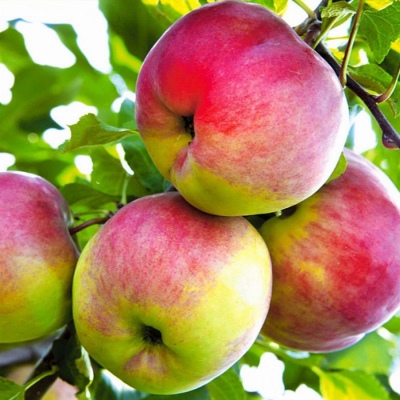
- Authors: Sverdlovsk Horticultural Selection Station, V. M. Aksyonov
- Taste: sweet and sour
- Scent: pleasant
- Fruit weight, g: 90-120
- Fruit size: average
- Yield: 15 to 18 kg of fruit per tree
- The beginning of fruiting varieties: for 3-4 years
- Ripening terms: late summer
- Removable maturity: mid-August
- Appointment: universal
The apple cultivar Aksen was bred by the specialist V.M. Aksenov at the Sverdlovsk horticultural selection station. To get a successful harvest, you should be well acquainted with the peculiarities of the agricultural technology of the Aksena variety.
Description of the variety
The variety is characterized by the following external differences:
tree of medium vigor, small, up to 4 m high;
the crown is dense, round-spreading in shape;
leaves are light green, elongated, rounded-oval;
flowers are small, 5 cm in diameter.
Features, pros and cons
The presented variety has good adaptive abilities. Other features include the following benefits:
high immunity to diseases and pest attacks;
frost resistance;
good taste properties of fruits;
the yield is above average.
Among the disadvantages can be noted the short shelf life of apples, but they are well suited for processing, so this problem can be solved.
Ripening and fruiting
Aksena is an apple variety with late summer ripening. Harvesting maturity occurs in mid-August. The first fruits can be obtained in 3-4 years of growing season.
Yield
One tree produces an average of 15-18 kg of fruit.
Fruits and their taste
The fruits have a yellowish, bright red integumentary color. Their shape is rounded and slightly flattened at the top and bottom. Average size, weight - 90-120 g. Apples taste sweet and sour, some note lingonberry notes, pleasant aroma. The pulp is fine-grained, dense, medium juiciness, crunchy. Taste properties are rated on a five-point scale at 4.3-5.

Growing features
A good harvest largely depends on the planting technology. Before planting, follow a few guidelines.
For planting, choose a loamy area that is well lit by the sun. A close occurrence of groundwater is desirable, since it is a rather moisture-loving variety.
The optimal time for planting is spring, a period when the earth is already warm enough.
Before planting, dig a hole according to the size of the root system, place a seedling there, cover it with fertile soil, tamp and water the area.
In order for the tree to feel good and bear fruit successfully, there are several factors to consider.
The apple tree will grow well if the foliage is thinned once a month. It is also important to regularly remove dry and weak branches.
It is enough to water the seedling a couple of times a month, and in the dry season - once a week. The tree needs 20-30 liters of water at a time.
For normal development, the culture needs the formation of a crown. To do this, in the spring, you need to eliminate all lateral shoots and leave only skeletal branches at 2-3 levels. The trunk should be cut once a year by 20-30% for three years - during this time the tree will form a rounded crown.



Pollination
Aksena is a self-pollinated variety that does not need other pollinators. Experienced summer residents during flowering process the tree with a sweet solution that attracts beneficial pollinating insects.
Top dressing
You need to fertilize the culture three times per season.
In early spring, root additives are relevant, for example, humus, superphosphates, wood ash.
During the flowering period, trees are treated with nitrogen compounds.
After harvesting, the plant is fertilized with potash mixtures and compost.

Frost resistance
This is a variety with a high level of frost resistance, so it is suitable for growing in regions with severe winters, for example, in the Middle Urals.

Diseases and pests
Aksena is highly resistant to diseases and pest attacks, the variety is not affected even by such a common apple disease as scab. As a preventive measure, you can whitewash the trunks of young trees with garden paint, this not only protects against harmful insects, but also protects against thermal burns. In addition, some gardeners tie spruce branches around the shrub for the winter to protect the bark from mice and rats.

The apple tree is a popular fruit crop among gardeners. It can be found in many summer cottages. But at the same time, such trees are often affected by various diseases. It is very important to recognize the disease in time and carry out the necessary procedures for a speedy recovery. Otherwise, the fruits will be spoiled, and the tree itself may die altogether.












































































